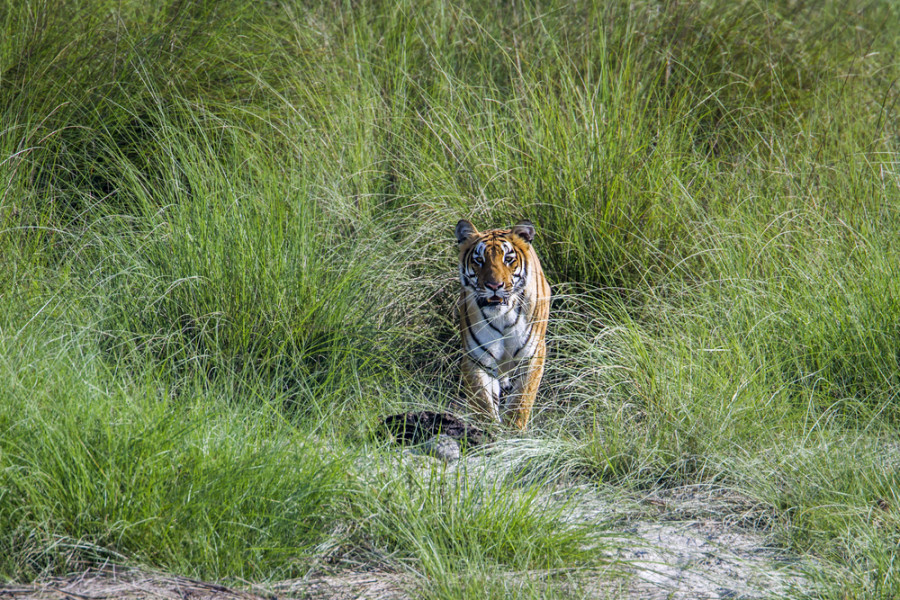Climate & Environment
Authorities scramble to deal with tiger threat in Kailali
While conservationists call for relocation, the district administration has already issued an order saying the animal can be killed if required.
Chandan Kumar Mandal
Authorities in Kailali are pondering over their next move as a tiger unleashes terror in parts of the district.
The animal, which is suspected to have killed a woman and wounded another in the last few days, mauled Kala Dhami, 25, of Gauri Ganga Municipality-5, Andaiya, to death at Pushpanjanli Community Forest on Sunday.
The frequent sighting of tigers and subsequent attacks on people has left residents of Gauri Ganga Municipality and Kailari Rural Municipality worried, and local authorities are scrambling to deal with the situation. According to Lajuram Chaudhary, mayor of Kailari Rural Municipality, locals are even scared of walking in the open because of the tiger menace.
“Since a tiger attacked and killed the woman, the general public is living in fear,” Chaudhary told the Post from Kailali. “Locals have been saying that a tiger and three cubs have been spotted in the nearby jungle in the past few months. But no one is sure whether the same tiger is the one wreaking havoc.”
Following frequent attacks and sightings along the East-West Highway, authorities in the district have been trying to take the tiger under control before it causes more damages to nearby settlements.
According to Ram Chandra Kandel, Chief of Division Forest Office, Kailai, the tiger has been roaming the area, where the woman was killed, for the last five days. “We have been continuously monitoring its movement. The forest office has also installed 11 camera traps to watch over its movement and also called wildlife technicians to control the wildcat,” said Kandel. “If it causes more damage to locals, then we will have to relocate it.”
With the population of tigers increasing in the country, the animal has been straying outside the forest and attacking local residents more frequently than in the past. Such attacks have been recurrent in areas adjoining Chitwan and Bardia national parks—two protected areas with large populations of tigers.
Six people have already died in tiger attacks in and around the Bardia National Park this fiscal year. In Chitwan, two men have lost their lives in tiger attacks this fiscal year.
Forest officials in Kailali district suspect that the tiger came to Nepal from Dudhwa National Park through the Basanta Corridor in India. The Basanta corridor encompasses an area of 65,500 hectares, connecting Suklaphanta National Park and Bardia National Park in Nepal with Dudhwa National Park in India through the forests of the Churia foothills. Tigers and rhinos are known to be using the corridor.
While the forest officials have been considering measures to tame the tiger, the District Administration Office, Kailali has given orders to even kill the tiger, if required. According to Hiralal Chaudhary, assistant chief district officer of Kailali, the order has been issued as per the Local Administration Act, 1971.
“Security forces have been mobilised after residents requested us to do so,” Chaudhary told the Post. “The tiger should be brought under control first. If that can’t happen, then it can be killed if the situation demands.”
The decision to kill the tiger will be made evaluating the situation, according to Chaudhary, assistant chief district officer of Kailali.
“We are not going for the extreme measures immediately,” said Chaudhary. “But if there is a sudden encounter in the jungle or the tiger turns into a ‘man-eater’, then it can be killed.”
Forest and wildlife officials at the district and centre, however, say the tiger should be protected rather than executed for attacking people.
“If the tiger attacks more people, then we must dart, capture it and relocate it,” said Kandel, chief at division forest office, Kailali. “We can not simply kill valuable wildlife like a tiger.”
Haribhadra Acharya, spokesperson for the Department of National Park and Wildlife Conservation, the central body responsible for the management of protected parks and wildlife living in those areas, also said killing the tiger would not be an ideal option.
“How many tigers will we kill for attacking locals? Locals have to head to safe places if tigers are seen, instead of taking photos or video,” said Acharya, also an ecologist with the department. “We can’t simply kill a tiger calling it a ‘man-eater’ unless it frequently kills people by entering into human settlements. Authorities should relocate it to a safer place as rearing a tiger takes years of conservation efforts.”




 16.12°C Kathmandu
16.12°C Kathmandu











